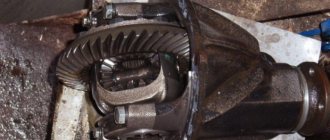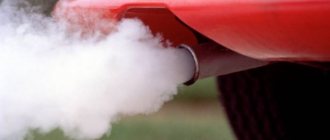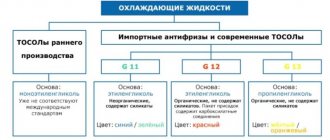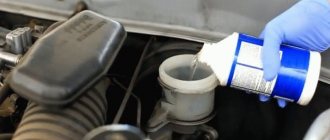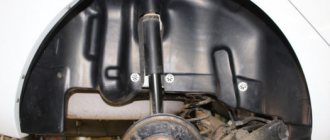The domestic ten is one of the most common cars in the CIS countries. The increased popularity raises questions such as what kind of oil to fill in the VAZ 2110. Additionally, this is due to the abundance of garage “masters” who know absolutely everything. However, car care requires a more careful approach and compliance with factory requirements.
Engine oil
The manufacturer pours fairly simple liquids into the power plant of the domestic dozen, which makes it possible to maintain the machine on a budget.
What kind of oil is poured at the factory?
The original VAZ 2110 oil may differ depending on the year of manufacture and version of the car. In recent years, the manufacturer has been using products such as TNK Super Oil with a viscosity of 10W40. The stock lubricant is quite stable under load and withstands the full service interval. Also, depending on the country where the car will go, the viscosity of the liquid may differ. The only stable parameter is the API SG/CD tolerance. It also has ACEA A3/B3 approval
The service manual contains information specifically about this oil.
Factory approvals
The standard tens motor does not have a complex design or increased demands on the quality of consumables. The only API SG/CD approval is indicated in the vehicle service manual. This mixture is intended for atmospheric internal combustion engines, where there are moderate loads and there are no complex exhaust gas purification systems.
Separately, the manufacturer does not prohibit the use of higher quality products.
Viscosity
The plant supplies the market with cars filled with semi-synthetic lubricant with a viscosity of 10W40. The optimal indicator for the central zone of the Russian Federation, where there are no severe frosts and moderate summers.
The engine itself is designed taking into account the possibility of using liquids, without reference to thickness. Thus, the user is recommended to select the viscosity of the mixture based on specific climatic conditions.
The basis
There are three types of liquids on the 2020 market.
- Mineral. Motor oils of this category are produced by simple distillation of sulfurous petroleum. The procedure helps remove coarse impurities and improve the properties of the finished formula. Due to low efficiency, mineral water is not used in modern cars.
- Semi-synthetic. A more advanced type of lubricant, recommended by the plant as the main working fluid. Oils can be made by mixing artificial and natural components or by hydrocracking oil. Due to the optimal price and effective motor protection, users prefer this class.
- Synthetics. Fully synthetic oils are produced from gas or other hydrocarbon sources. Fluids provide excellent protection for internal combustion engines from premature wear, aging and sludge formation. Increased efficiency also has a downside - oils are very expensive.
How much to fill
A standard 10-cylinder in-line four-cylinder engine requires only 3.5 liters of lubricant. The small crankcase compartment is supplemented by an oil filter, which holds another 200 ml of lubricant.
Therefore, a 4 liter canister is sufficient to replace the formula.
How many liters of oil are in a VAZ 2107 engine
In the technical documentation for the car, it is written that volume for the VAZ 2107 is 3.75 liters. But experts advise buying a 4 liter canister.
When replacing lubricating fluid, you should adhere to certain rules that will help keep the engine in order:
- for new engines ;
- do not experiment with new mixtures and choose a product of the same brand that you used before;
- Leave it to a professional or carefully read the instructions and warnings regarding replacement yourself.
Oil in box
The VAZ 2110 is supplied to the market with a front-wheel drive 5-speed manual, standard for its class. The box requires filling only with API GL-4/5 oils - standard motor oil for manual transmissions. In terms of viscosity, the recommended lubricant has a specification of 75W90, but in some cases you can buy oil for a VAZ 2110 box with other indexes suitable for specific conditions.
Synthetics are used as a base; the unit is serviced every 30,000 kilometers. To change the lubricant you will need 3.5 liters.
How much oil to pour into the VAZ 2111 engine
First generation 2111, 1998-2009
The VAZ-2111 station wagon was considered the most practical and expensive representative of the Lada 110 family. From the 2110 sedan, the five-door model received an identical design for the front part of the body, as well as the rear lights. In addition to the increased trunk, there was also the opportunity to place cargo on the roof thanks to roof rails, which the sedan never had. Despite the appearance of the successor to the Lada Priora in 2007, the station wagon remained relevant for a long time. It was offered with a 1.5 carburetor engine, as well as 1.5 and 1.6 engines with an injection power system.
Also read: Engine oil for Chery Tiggo 7 engine
Gasoline engines 1998-2009
- 1.5 73 l. With. (2110), oil volume - 3.5 liters, tolerance and viscosity: API-SG, SH, SJ, SL; SAE 5W-40, 10W-40, 10W-30, 5W-30, 0W-30, 0W-40, 20W-40, 25W-50
- 1.5i 77 l. With. (21110), oil volume - 3.5 liters, tolerance and viscosity: API-SG, SH, SJ, SL; SAE 5W-40, 10W-40, 10W-30, 5W-30, 0W-30, 0W-40, 20W-40, 25W-50
- 2.0 148 l. With. (X20XEV), oil volume - 4.5 liters, tolerance and viscosity: API-SG, SH, SJ, SL; SAE 5W-40, 10W-40, 10W-30, 5W-30, 0W-30, 0W-40, 20W-40, 25W-50
Elimination of illiteracy
If you are interested in what kind of oil the engineers of the Volzhsky Automobile Plant recommend to fill into the power units of classic Lada cars - mineral, semi-synthetic or synthetic, then you are formulating the question incorrectly. The manufacturer's recommendations relate only to the quality standards that the engine oil being poured must meet.
Many people notice that product canisters usually have markings like API SH or API SJ/CF. You should pay attention to it first of all, since it is this marking that informs about the quality of the product.
API is an acronym for the American Petroleum Institute. This institute checks whether motor oil meets certain quality standards based on a large number of indicators, including:
- the amount of deposits remaining on engine parts after a standard period of operation;
- washing ability;
- temperature characteristics;
- toxicity;
- corrosivity;
- effectiveness of protecting engine parts from friction.
The abbreviations SJ or CF are deciphered as follows.
- S and C are the categories of engines for which the oil is intended. Lubricants for gasoline power units are designated by the letter S, and lubricants for diesel engines by the letter C.
- J and F – quality of oil performance characteristics. The farther the letter is from A in alphabetical order, the higher the product characteristics.
Engineers at the Volzhsky Automobile Plant require that the engine of the VAZ 21074 injector be filled with lubricant that at least meets the API SG/CD standard. Moreover, if you come across a product that meets the API SH, SJ or SL standard, then it is better to fill it.
Quite often, when purchasing motor oil, car enthusiasts first of all pay attention to the classification of the product according to the methodology of the US Society of Automotive Engineers (SAE). However, such a classification only determines the viscosity characteristics of the product and does not inform in any way about its quality.
- Lukoil Lux – 5W40, 10W40, 15W40.
- Lukoil Super - 5W30, 5W40, 10W40, 15W40.
- Novoil-Sint – 5W30.
- Omskoil Lux – 5W30, 5W40, 10W30, 10W40, 15W40, 20W40.
- Norsi Extra – 5W30, 10W30, 5W40, 10W40, 15W40.
- Esso Ultra – 10W40.
- Esso Uniflo – 10W40, 15W40.
- Shell Helix Super – 10W40.
What kind of oil should I use?
VAZ engineers advise filling VAZ 2107 engines with an injector with oil that meets API SG/CD standards. A lubricant with API SH, SJ or SL parameters is even better.
Often, when purchasing engine oil, motorists first pay attention to the classification of the product according to the principles of the Society of Automotive Engineers of America - SAE. This classification determines only the viscosity of the product, not the quality. The car manufacturer recommends the following brands of oils:
- Esso Ultra – 10W40;
- Esso Uniflo – 10W40, 15W40;
- Lukoil Lux – 5W40, 10W40, 15W40;
- Lukoil Super - 5W30, 5W40, 10W40, 15W40;
- Omskoil Lux – 5W30, 5W40, 10W30, 10W40, 15W40, 20W40;
- Novoil-Sint – 5W30;
- Norsi Extra – 5W30, 10W30, 5W40, 10W40, 15W40;
- Shell Helix Super – 10W40.
How much oil is needed for a VAZ 2107 engine
According to the manufacturer, the amount of oil in the system, including the filter, is 3.75 liters. Taking into account waste compensation, a 4-liter canister of oil is enough to fill the system and top up during operation. [tip]
Expert advice:
- When changing oil, it is better to fill in the brand that was used before. If the type of old and new oil does not match (for example, “synthetic” after “mineral oil”), it is better to flush the system after draining the old oil.
- Synthetic oil should not be used in older engines. Due to the increased cleaning properties of “synthetics”, it can wash away deposits that cover microcracks in the crankcase.
- It is better to fill a new engine exclusively with synthetic oil. This will prevent it from overheating and significantly increase its resource. Therefore, immediately after break-in, it is necessary to drain the oil filled at the factory and fill the system with “synthetics”.
- Regardless of the engine mileage, timely replacement of lubricants will increase its service life and increase reliability.
The far-fetched problem of choosing oil for the VAZ 2107 is not so difficult. It is enough to follow the manufacturer's quality recommendations and purchase the desired type of oil, based on operating conditions (cold or warm climate), engine condition and financial capabilities.
Methods for determining the need for replacement, filling volumes and expert advice
If an oil pressure sensor is installed on the engine of your car, this makes it much easier to determine the moment after which a scheduled lubricant change is required in the VAZ 2107 engine. To determine the exact moment, you need to pay attention to the lubricant pressure in different operating ranges of the power unit. Usually, when the lubricant decomposes, the VAZ 2107 oil pressure indicator (installed on all cars produced before 1988) shows an increase in pressure in the system during startup and long-term operation of the power unit.
This happens due to liquefaction and boiling of the lubricant in the crankcase of the power unit. If there is no oil pressure sensor on your car, then you will have to rely on the recommendations of the car manufacturer. AvtoVAZ engineers advise changing the lubricant in the engine every 6,000 km when driving short distances and every 10,000 km when driving constantly over long distances.
Many owners of classic cars are interested in the question of how much oil should be poured into the lubrication system of the power unit of their favorite car. According to the manufacturer, the volume of engine oil in the engine lubrication system is about 4 liters, or more precisely, 3750 milliliters, including lubricant in the filter. Expert advice.
- When changing oil, it is better to fill in the brand that was poured into the engine crankcase before.
- It is not recommended to fill old power units with synthetics, since it washes out deposits covering microcracks in the oil sump.
- It is better to immediately fill a new factory engine that has been run-in with synthetics. In a good engine, synthetics are welcome; they will prevent it from overheating and extend its service life.
Regardless of how much your car has driven, if you change consumables and operating fluids on time, your car will delight you with its reliability for many years.
OIL SELECTION CRITERIA
The best are synthetic oils, with artificial additives, for example, removing deposits, protecting metal from destruction, and binding sulfur oxides. “Synthetics” have high fluidity, therefore, minimal resistance and friction in blocks and units.
But they are not suitable for old cars, for example, winter oil for a VAZ 2107 with a worn-out engine should not be synthetic, since it cannot produce normal pressure on a warm engine.
Old models require lubricant of a uniform and constant consistency that does not change in cold weather (up to –40 degrees). For example, Shell oil will ensure reliable starting, a low load on the starter (battery) of the car, and will “significantly” reduce the wear of working parts at sub-zero temperatures.
The cleanliness of the exhaust is also important; the lubricant should have a positive effect on it and “keep it in compliance with Euro standards.” When choosing the best winter motor oil, do not forget about its ability to cleanse deposits. Castrol (British Petroleum) products are often included in the ratings for this parameter, forming a viscous protective film in places of strong friction (in other places - liquid). Recommended for passenger cars and commercial vehicles with any engines, in particular, the oil is certified for VAZ cars.
It is believed that the best winter synthetic engine for these machines, such as 5W40 or 5W30, fully ensures winter stability - the ability not to change the consistency in severe frost, and therefore ensure easy engine starting. It is suitable for use in most of Russia.
If you change the oil yourself, then please note that what is sold at Russian branded gas stations (LUKOIL, TNK, Rosneft, etc.) should not be counterfeit and is sometimes cheaper.


